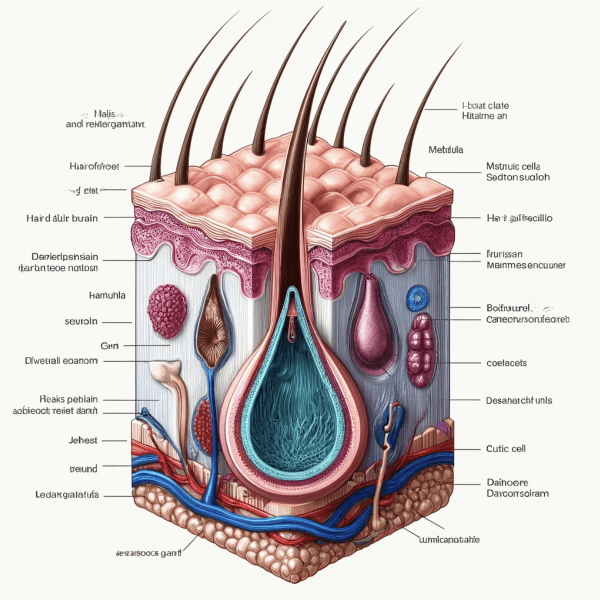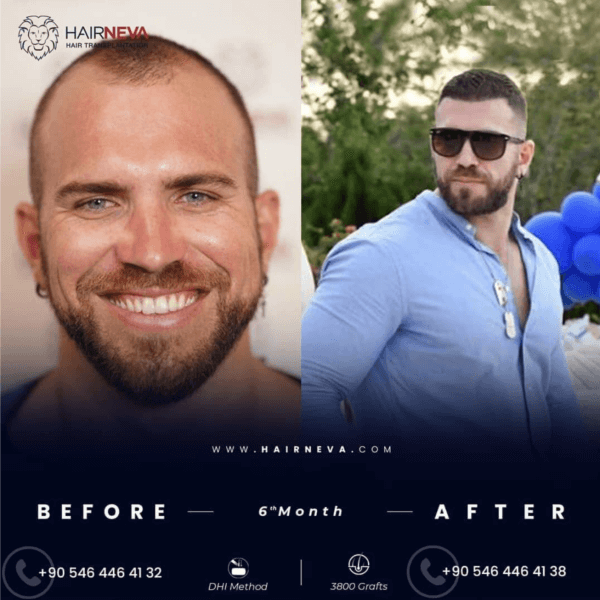Have you ever wondered why some hair transplant procedures yield remarkable results while others fall short of expectations? The key lies in understanding the intricate anatomy of hair follicles and how it influences the success of transplant surgeries. In this comprehensive guide, we will delve into the fascinating world of hair follicle anatomy, exploring its relevance in achieving optimal outcomes in hair restoration procedures.
Hair follicles, the microscopic structures responsible for hair growth, are marvels of biological engineering. Understanding their intricate anatomy is crucial for both appreciating the complexities of hair growth and optimizing outcomes in hair transplant procedures. By delving into the structure and function of hair follicles, we gain valuable insights into the factors influencing transplant success and the principles guiding surgical intervention.
Exploring the Hair Follicle Anatomy
At the heart of every hair restoration procedure lies the hair follicle – a complex structure responsible for hair growth and regeneration. Understanding the anatomy of hair follicles is essential for hair transplant surgeons to execute precise and effective procedures. Let’s take a closer look at the components of a hair follicle:
Hair Bulb: The hair bulb is the lowest part of the hair follicle, situated beneath the scalp’s surface. It houses the dermal papilla and matrix cells responsible for hair growth. The dermal papilla supplies nutrients to the hair bulb, supporting the growth of new hair fibers.
Dermal Papilla: The dermal papilla is a cluster of specialized cells located at the base of the hair bulb. It plays a crucial role in regulating hair growth by interacting with surrounding epithelial cells. The dermal papilla receives signals from the body’s circulatory system and secretes growth factors essential for maintaining the hair growth cycle.
Matrix Cells: The matrix cells are located within the hair bulb and are responsible for producing new hair cells through a process called mitosis. As matrix cells divide and proliferate, they push older cells upwards, forming the hair shaft that emerges from the scalp.
Hair Shaft: The hair shaft is the visible part of the hair that extends beyond the scalp’s surface. It consists of three layers: the medulla, cortex, and cuticle. The medulla is the innermost layer, followed by the cortex, which contains pigment-producing cells called melanocytes. The outermost layer is the cuticle, composed of overlapping keratin scales that protect the hair shaft from damage.
Sebaceous Gland: The sebaceous gland is attached to the hair follicle and produces sebum, an oily substance that lubricates the hair and skin. Sebum helps keep the hair moisturized and provides a protective barrier against environmental pollutants and pathogens.

Understanding the intricate structure of hair follicles is crucial for hair transplant surgeons to extract and transplant follicular units effectively. By preserving the integrity of the hair follicles during transplantation, surgeons can maximize graft survival and ensure natural-looking results for their patients.
Practical Tips for Hair Transplant Success
Now that we’ve gained insight into the anatomy of hair follicles, let’s explore some practical tips for achieving successful hair transplant outcomes:
Choose an Experienced Surgeon: Selecting a board-certified hair transplant surgeon with extensive experience and a proven track record is essential for achieving optimal results. Research prospective surgeons, read patient reviews, and view before-and-after photos to assess their expertise and competence.
Discuss Treatment Options: During your consultation, discuss your hair restoration goals and concerns with your surgeon. They will evaluate your scalp condition, assess your candidacy for hair transplant surgery, and recommend the most suitable treatment approach, whether it’s follicular unit extraction (FUE), follicular unit transplantation (FUT), or a combination of both techniques.
Follow Pre-Operative Instructions: Your surgeon will provide pre-operative instructions to prepare you for the transplant procedure. Follow these guidelines carefully, which may include refraining from certain medications, avoiding alcohol and smoking, and maintaining a healthy diet to optimize healing and graft survival.
Post-Operative Care: After your hair transplant procedure, adhere to your surgeon’s post-operative care instructions to promote healing and minimize complications. Avoid strenuous activities, protect your scalp from direct sunlight, and follow a prescribed medication regimen to prevent infection and inflammation.
By understanding the anatomy of hair follicles and following these practical tips, you can increase the likelihood of achieving successful outcomes in your hair transplant journey. Understanding the intricate anatomy of hair follicles is essential for achieving optimal outcomes in hair transplant surgery. By leveraging advanced techniques and emerging trends in hair restoration, surgeons can enhance graft survival rates, promote natural-looking results, and improve patient satisfaction.
Scalp Health and Maintenance for Long-Term Success
While surgical precision and advanced techniques play a crucial role in the success of hair transplant procedures, the health of the scalp and ongoing maintenance are equally important factors to consider. Let’s delve into the significance of scalp health and explore strategies for ensuring long-term transplant success:
Preoperative Scalp Assessment: A thorough preoperative scalp assessment is essential to identify any underlying conditions or issues that may affect the success of the transplant. Conditions such as scalp psoriasis, seborrheic dermatitis, or scalp infections can compromise the viability of transplanted follicles and impede hair growth. Addressing these issues prior to surgery through appropriate medical management can optimize transplant outcomes and minimize the risk of complications.
Postoperative Care and Hygiene: Following hair transplant surgery, patients must adhere to strict postoperative care instructions to promote proper healing and graft survival. This includes gentle cleansing of the scalp with mild, non-abrasive shampoos and avoiding excessive manipulation or rubbing of the transplant area. Patients should also refrain from strenuous physical activity and exposure to direct sunlight during the initial healing phase to prevent damage to newly transplanted follicles.
Nutrition and Lifestyle Factors: A balanced diet rich in essential nutrients, vitamins, and minerals is vital for maintaining overall scalp health and supporting optimal hair growth. Nutrients such as vitamin A, vitamin C, biotin, and omega-3 fatty acids play key roles in promoting hair strength, thickness, and vitality. Additionally, adopting a healthy lifestyle that includes regular exercise, adequate hydration, and stress management can contribute to improved scalp circulation and hair follicle function.
Scalp Massage and Stimulation: Regular scalp massage can help improve blood circulation to the scalp, thereby delivering vital nutrients and oxygen to the hair follicles. Gentle massage techniques can also stimulate the hair follicles and promote hair growth by prolonging the anagen (growth) phase of the hair cycle. Incorporating scalp massage into a daily grooming routine can enhance the overall health and vitality of the scalp, supporting the long-term success of hair transplant procedures.
Use of Medical Therapies: In some cases, medical therapies such as minoxidil (Rogaine) or finasteride (Propecia) may be prescribed to complement hair transplant surgery and enhance hair growth. Minoxidil is a topical medication that promotes hair regrowth by stimulating hair follicles and increasing blood flow to the scalp. Finasteride is an oral medication that inhibits the conversion of testosterone to dihydrotestosterone (DHT), a hormone implicated in hair loss. By addressing underlying hormonal imbalances and promoting hair follicle health, these medications can help optimize transplant results and maintain long-term hair density.
Achieving optimal outcomes in hair transplant surgery requires a comprehensive approach that encompasses surgical expertise, advanced techniques, and diligent postoperative care. By prioritizing scalp health and implementing strategies for ongoing maintenance, patients can maximize the success of their transplant and enjoy natural-looking, long-lasting results. If you’re considering a hair transplant procedure, consult with a board-certified hair restoration specialist to explore your options and develop a personalized treatment plan tailored to your needs.
Real-world Application: Elevating Transplant Success with Roberto’s Hair Transplant Journey

Meet Roberto, a 35-year-old man from Brazil who had been struggling with hair loss since his early twenties. Despite trying various hair growth treatments and products, Roberto’s confidence took a hit as he watched his hairline recede and his once-thick locks thinning.
Like many individuals facing hair loss, Roberto’s self-esteem suffered, impacting his personal and professional life. He longed to regain his youthful appearance and confidence but was hesitant about undergoing a hair transplant procedure, especially in a foreign country.
After extensive research and deliberation, Roberto stumbled upon Nova Clinic in Turkey, renowned for its expertise in Afro hair transplants. Despite initial doubts and concerns, Roberto was intrigued by the positive testimonials and success stories from previous patients.
With newfound hope, Roberto decided to embark on his hair transplant journey with Nova Clinic. From the moment he reached out to them, Roberto was impressed by their professionalism, transparency, and commitment to patient care. The clinic’s comprehensive pre-operative consultations provided Roberto with detailed information about the procedure, expected outcomes, and post-operative care.
Arriving in Turkey, Roberto and his wife Claudia were warmly welcomed by the clinic’s staff, who made them feel right at home. Despite being in a foreign country, Roberto felt reassured by the trust and confidence instilled in him by the clinic’s team.
The day of the surgery arrived, and Roberto was filled with a mix of nerves and excitement. The meticulous planning and attention to detail during the procedure left Roberto impressed. The surgeon carefully analyzed Roberto’s hairline and discussed his aesthetic goals, ensuring a personalized treatment plan tailored to his needs.
Throughout the surgery, Roberto experienced minimal discomfort, thanks to the advanced anesthesia techniques used by the clinic. The skilled medical team worked diligently to extract hair grafts from the donor area and implant them into the recipient sites, ensuring a natural-looking result.
Following the surgery, Roberto received thorough post-operative care instructions and support from the clinic’s staff. From gentle washing routines to personalized medication prescriptions, Roberto felt well-cared for every step of the way.
As the days passed, Roberto’s confidence began to soar as he witnessed the gradual growth of his transplanted hair. With each passing week, Roberto’s hairline became fuller and more defined, restoring his youthful appearance and self-assurance.
Reflecting on his hair transplant journey, Roberto couldn’t be happier with the results. Not only did the procedure transform his physical appearance, but it also rejuvenated his confidence and outlook on life. Roberto is grateful to Nova Clinic for their expertise, professionalism, and unwavering support throughout his transformative journey.
Today, Roberto proudly flaunts his thick, luscious locks, radiating confidence and happiness wherever he goes. His hair transplant experience with Hairneva Clinic has not only changed his appearance but has also empowered him to embrace life with renewed vigor and optimism.


